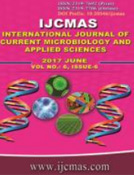


 National Academy of Agricultural Sciences (NAAS)
National Academy of Agricultural Sciences (NAAS)

|
PRINT ISSN : 2319-7692
Online ISSN : 2319-7706 Issues : 12 per year Publisher : Excellent Publishers Email : editorijcmas@gmail.com / submit@ijcmas.com Editor-in-chief: Dr.M.Prakash Index Copernicus ICV 2018: 95.39 NAAS RATING 2020: 5.38 |
More than sixty million Indians reside in endemic areas of fluorosis and are at risk of developing fluorosis in 200 districts from 20 states of India. Keeping in mind the severity of fluoride (F) problems, this study is an effort to investigate the effect of F contaminated soils on germination, plant growth and physiology of important pulse, mung bean (Vigna radiata) and green leafy vegetable spinach (Spinacia oleracea). This study was carried out with completely randomized block design under controlled environmental conditions in green house. The results of this study showed that under high (Sodium fluoride) NaF conc. (0.15mg/l), the percent germination was observed to be decreased by 20% in spinach compared to control. Similarly, the shoot length was found to be decreased more in spinach (51%), than in mung bean. The root length was also observed to decrease by 64.3% and 59.6% in mung bean and spinach respectively as compared to control, indicating the differential sensitivity of these crops. The content of chlorophyll-a, chlorophyll-b and total chlorophyll of leaves in both the crops decreased monotonically as toxicity level of F increased. Treatment with highest F concentration (0.15 mg/l), showed decreased vigour index in spinach. Shoot dry wt. was positively correlated (p<0.05) with root length, chl a, b and total chl., root dry wt. and root shoot ratio. However, shoot dry wt. was negatively correlated with shoot length, seed germination and vigour index. This study concludes that soil contaminated with F has negative efffects on the growth physiology and biochemical characteristics of mung bean and spinach.
 |
 |
 |
 |
 |